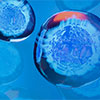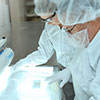BIOTIUM, INC
Supplier:
Biotium
Description:
CF®DI dye hydrazides react with molecules containing aldehyde or ketone groups to form a hydrazone bond. The dyes are size- and charge-matched and do not significantly alter the molecular weight or pI of the labeled proteins. They are used for detection of protein carbonylation by fluorescence 2D-DIGE.
Supplier:
Biotium
Description:
Mucin 5AC (MUC5AC), Monoclonal antibody, Clone: 45M1, Host: Mouse, Species reactivity: Mouse, Hedgehog, Monkey, Pig, Cat, Rat, Human, Chicken, Rabbit, Isotype: IgG1, kappa, Conjugate: CF647, Synonyms: Apomucin Major Airway Glycoprotein, Size: 500uL
Supplier:
Biotium
Description:
This antibody recognizes a protein of 185 kDa, which is identified as c-erbB-2/HER-2/neu. Its epitope is localized in the extracellular domain. C-erbB-2/HER-2 is a member of the EGFR family. This MAb is specific and shows minimal cross-reaction with other members of the EGFR-family. Receptors of this family are located on the plasma membrane and consist of an extracellular ligand-binding domain that is connected to a large intracellular domain by a single transmembrane sequence. c-erbB-2/HER-2 protein is over-expressed in a variety of carcinomas especially those of breast and ovary.
CF® dyes are Biotium's next-generation fluorescent dyes. CF®488A is a green fluorescent dye (Ex/Em 490/515 nm) with excellent brightness and photostability. The dye is minimally charged for less non-specific binding. CF®488A also is compatible with super-resolution imaging by TIRF.
Supplier:
Biotium
Description:
Cytokeratin 14 (CK14) belongs to the type I (or A or acidic) subfamily of low molecular weight keratins and exists in combination with keratin 5 (type II or B or basic). CK14 is found in basal cells of squamous epithelia, some glandular epithelia, myoepithelium, and mesothelial cells. Anti-CK14 is useful in differentiating squamous cell carcinomas from poorly differentiated epithelial tumors. Anti-CK14 is one of the specific basal markers for distinguishing between basal and non-basal subtypes of breast carcinomas. Anti-CK14 is also a good marker for differentiation of intraductal from invasive salivary duct carcinoma by the positive staining of basal cells surrounding the in-situ neoplasm as well as for differentiation of benign prostate from prostate carcinoma. Furthermore, this antibody has been useful in separating oncocytic tumors of the kidney from its renal mimics, and in identifying metaplastic carcinomas of the breast.
Supplier:
Biotium
Description:
CD63 Monoclonal antibody, Clone: NKI-C3, Host: Mouse, Species reactivity: Mouse, Human, Isotype: IgG1, kappa, Conjugate: CF488A, Immunogen: Smooth plasma membrane fraction of MeWo cells, Application: IF, Immunohistology (formalin), Western, FC, Size: 100uL
Supplier:
Biotium
Description:
This antibody recognizes a protein of 40 kDa, identified as cytokeratin-19 (CK19), which is expressed in sweat gland, mammary gland ductal and secretory cells, bile ducts, gastrointestinal tract, bladder urothelium, oral epithelia, esophagus, and ectocervical epithelium. Anti-CK19 reacts with a wide variety of epithelial malignancies including adenocarcinomas of the colon, stomach, pancreas, biliary tract, liver, and breast. Perhaps the most useful application is the identification of thyroid carcinoma of the papillary type, although 50%-60% of follicular carcinomas are also labeled. Anti-CK19 is a useful marker for detection of tumor cells in lymph nodes, peripheral blood, bone marrow and breast cancer.
CF® dyes are Biotium's next-generation fluorescent dyes. CF®640R is a far-red fluorescent dye (Ex/Em 642/662 nm) with excellent brightness, and the best photostabiity among spectrally-similar dyes.
Supplier:
Biotium
Description:
Cytokeratin 19 Monoclonal antibody, Clone: A53-B/A2.26, Host: Mouse, Species reactivity: Human, Isotype: IgG2a, kappa, Conjugate: CF555, Immunogen: Human breast cancer MCF-7 cells, Synonyms: k19, k1cs, krt19, Application: IF, IHC, FC, Size: 100uL
Supplier:
Biotium
Description:
Cytokeratin 19 Monoclonal antibody, Clone: A53-B/A2 + BA17, Host: Mouse, Species reactivity: Human, Isotype: IgG's, Conjugate: CF568, Immunogen: Human breast cancer MCF-7 cells, Synonyms: k19, k1cs, krt19, Application: IF, Size: 500 uL
Supplier:
Biotium
Description:
CD86 Monoclonal antibody, Clone: BU63, Host: Mouse, Species reactivity: Mouse, Rat, Human, Isotype: IgG1, kappa, Conjugate: CF568, Immunogen: ARH-77 (B-lymphoblastoid cell line), Application: IF, Immunohistology, Immunoprecipitation, Western, FC, Size: 100uL
Supplier:
Biotium
Description:
CD86 Monoclonal antibody, Clone: C86/1146, Host: Mouse, Species reactivity: Mouse, Rat, Human, Isotype: IgG s, Conjugate: CF640R, Immunogen: Recombinant human full-length CD86 protein, Application: Immunofluorescence, Flow cytometry, Size: 500 uL
Supplier:
Biotium
Description:
CD79 is a disulfide-linked heterodimer of mb-1 (or CD79a) and B29 (or CD79b) polypeptidesIt is non-covalently associated with membrane-bound immunoglobulins on B cells. This complex of mb-1 and B29 polypeptides and immunoglobulin constitute the B cell Ag receptor. CD79a first appears at pre B cell stage, early in maturation, and persists until the plasma cell stage where it is found as an intracellular component. CD79a is found in the majority of acute leukemias of precursor B cell type, in B cell lines, B cell lymphomas, and in some myelomas. It is not present in myeloid or T cell lines. Anti-CD79a is generally used to complement anti-CD20 especially for mature B-cell lymphomas after treatment with Rituximab (anti-CD20). This antibody will stain many of the same lymphomas as anti-CD20, but also is more likely to stain B-lymphoblastic lymphoma/leukemia than is anti-CD20. Anti-CD79a also stains more cases of plasma cell myeloma and occasionally some types of endothelial cells as well.
CF® dyes are Biotium's next-generation fluorescent dyes. CF®488A is a green fluorescent dye (Ex/Em 490/515 nm) with excellent brightness and photostability. The dye is minimally charged for less non-specific binding. CF®488A also is compatible with super-resolution imaging by TIRF.
Supplier:
Biotium
Description:
This antibody recognizes a 53 kDa protein, which is identified as p53 suppressor gene product. It reacts with the mutant as well as the wild form of p53 under denaturing and non-denaturing conditions. Its epitope maps within the N-terminus (aa 20-25) of p53 oncoprotein. p53 is a tumor suppressor gene expressed in a wide variety of tissue types and is involved in regulating cell growth, replication, and apoptosis. It binds to MDM2, SV40 T antigen and human papilloma virus E6 protein. Positive nuclear staining with p53 antibody has been reported to be a negative prognostic factor in breast carcinoma, lung carcinoma, colorectal, and urothelial carcinoma. Anti-p53 positivity has also been used to differentiate uterine serous carcinoma from endometrioid carcinoma as well as to detect intratubular germ cell neoplasia. Mutations involving p53 are found in a wide variety of malignant tumors, including breast, ovarian, bladder, colon, lung, and melanoma.
CF® dyes are Biotium's next-generation fluorescent dyes. CF®594 is a deep red fluorescent dye (Ex/Em 593/614 nm). It yields the brightest conjugates among spectrally similar dyes, and has excellent photostability.
Supplier:
Biotium
Description:
This antibody recognizes a protein of 40 kDa, identified as CD7 (also known as gp40, Leu9). CD7 is a member of the immunoglobulin gene superfamily. Its N-terminal amino acids 1-107 are highly homologous to Ig kappa-L chains whereas the carboxyl-terminal region of the extracellular domain is proline-rich and has been postulated to form a stalk from which the Ig domain projects. CD7 is expressed on the majority of immature and mature T-lymphocytes, and T cell leukemia. It is also found on natural killer cells, a small subpopulation of normal B cells and on malignant B cells. Cross-linking surface CD7 positively modulates T cell and NK cell activity as measured by calcium fluxes, expression of adhesion molecules, cytokine secretion and proliferation. CD7 associates directly with phosphoinositol 3'-kinase. CD7 ligation induces production of D-3 phosphoinositides and tyrosine phosphorylation.
CF® dyes are Biotium's next-generation fluorescent dyes. CF®647 is a far-red fluorescent dye (Ex/Em 650/665 nm) with excellent brightness. It also is compatible with super-resolution imaging by STORM.
Catalog Number:
(75919-844)
Supplier:
Biotium
Description:
This antibody recognizes a protein of 40 kDa, identified as cytokeratin-19 (CK19), which is expressed in sweat gland, mammary gland ductal and secretory cells, bile ducts, gastrointestinal tract, bladder urothelium, oral epithelia, esophagus, and ectocervical epithelium. Anti-CK19 reacts with a wide variety of epithelial malignancies including adenocarcinomas of the colon, stomach, pancreas, biliary tract, liver, and breast. Perhaps the most useful application is the identification of thyroid carcinoma of the papillary type, although 50%-60% of follicular carcinomas are also labeled. Anti-CK19 is a useful marker for detection of tumor cells in lymph nodes, peripheral blood, bone marrow and breast cancer.
Catalog Number:
(75919-792)
Supplier:
Biotium
Description:
This antibody recognizes a protein of 40 kDa, identified as cytokeratin-19 (CK19), which is expressed in sweat gland, mammary gland ductal and secretory cells, bile ducts, gastrointestinal tract, bladder urothelium, oral epithelia, esophagus, and ectocervical epithelium. Anti-CK19 reacts with a wide variety of epithelial malignancies including adenocarcinomas of the colon, stomach, pancreas, biliary tract, liver, and breast. Perhaps the most useful application is the identification of thyroid carcinoma of the papillary type, although 50%-60% of follicular carcinomas are also labeled. Anti-CK19 is a useful marker for detection of tumor cells in lymph nodes, peripheral blood, bone marrow and breast cancer.
Supplier:
Biotium
Description:
Cytochrome c is a well-characterized mobile electron transport protein that is essential to energy conversion in all aerobic organisms. In mammalian cells, this highly conserved protein is normally localized to the mitochondrial inter-membrane space. More recent studies have identified cytosolic Cytochrome c as a factor necessary for activation of apoptosis. During apoptosis, Cytochrome c is trans-located from the mitochondrial membrane to the cytosol, where it is required for activation of caspase-3 (CPP32). Overexpression of Bcl-2 has been shown to prevent the translocation of Cytochrome c, thereby blocking the apoptotic process. Overexpression of Bax has been shown to induce the release of Cytochrome c and to induce cell death. The release of Cytochrome c from the mitochondria is thought to trigger an apoptotic cascade, whereby Apaf-1 binds to Apaf-3 (caspase-9) in a Cytochrome c-dependent manner, leading to caspase-9 cleavage of caspase-3.
Inquire for Price
Stock for this item is limited, but may be available in a warehouse close to you. Please make sure that you are logged in to the site so that available stock can be displayed. If the
Stock for this item is limited, but may be available in a warehouse close to you. Please make sure that you are logged in to the site so that available stock can be displayed. If the
You must log in to order restricted items. We request that you provide the required business documentation to purchase this product for the first time.
To order chemicals, medical devices, or other restricted products please provide identification that includes your business name and shipping address via email CMD_NA@vwr.com or fax 484.881.5997 referencing your VWR account number . Acceptable forms of identification are:
-Additional Documentation May be needed to purchase this item. A VWR representative will contact you if needed.
This product has been blocked by your organization. Please contact your purchasing department for more information.
The original product is no longer available. The replacement shown is available.
This product is currently unavailable but limited stock may be available in our extended warehouse network. Please call 1-800-932-5000 and a VWR Customer Service Representative will help you.
|
|||||||||


































